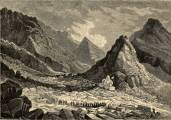
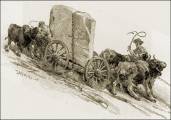

Structures and Monuments in Which
Kansas Stone was Used
(Page 6)
- Finished Products from Kansas Stone in Kansas (continued)
- Lawrence (northwest of), Douglas County, Kansas – 1879 Stone Barn (photograph)
-
The barn was constructed with Oread Limestone. Photograph courtesy of Grace Muilenburg, KGS, 1963. The source of this material is the Kansas Geological Survey web site at <http://www.kgs.ku.edu/>. All Rights Reserved.

- Lawrence, Kansas – Haskell Institute, Tecumseh Hall (1915) (photograph)
-
The Hall was constructed with Cottonwood Limestone. Photograph courtesy of Grace Muilenburg, KGS, 1962. The source of this material is the Kansas Geological Survey web site at <http://www.kgs.ku.edu/>. All Rights Reserved.
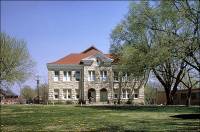
- Lawrence, Kansas – the Douglas County Courthouse (1100 Massachusetts) (photograph and history)
-
The Douglas County Courthouse was built of native Oread Limestone in 1904. (To view a photograph of the Courthouse and more history, click on the link above, choose “Attractions” in the LASR web site, then choose “Douglas County Courthouse.”) Click here to view a photograph of the Douglas County Courthouse presented by the Kansas Geological Survey; photograph courtesy of Grace Muilenburg, KGS, 1962. The source of this material is the Kansas Geological Survey web site at <http://www.kgs.ku.edu/>. All Rights Reserved.
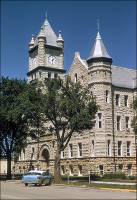
- Lawrence, Kansas –Kansas University, West Campus – the new Dole Institute & Archive. This building is under construction and completion
date was set for March 2003. It is noted in this web site that smooth
Kansas limestone is to be used on the curved facade and colonnade
located along the edge of the reflecting pool. Rough-hewn limestone
is to be used on the side walls. This web site includes several artist's
renderings of the completed structure. (The link from which the above information was obtained is no longer available.) <http://www.ku.edu/~fmkuhtml/dcm/projects/dolearch.htm>
- Bailey Hall (1900), on Mount Oread (photograph)
-
Toronto Limestone was used in the construction of Bailey Hall. Photograph courtesy of John Charlton, KGS, Dec. 2002. The source of this material is the Kansas Geological Survey web site at <http://www.kgs.ku.edu/>. All Rights Reserved. Click here to view another photograph and a history of Bailey Hall.
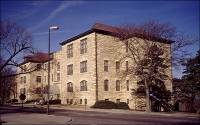
- Campanile (photograph)
-
According to the Kansas Geological Survey photograph caption for the Campanile, both Cottonwood Limestone and Ft. Riley Limestone were used in constructing the building. Photograph courtesy of Grace Muilenburg, KGS, May 1975. The source of this material is the Kansas Geological Survey web site at <http://www.kgs.ku.edu/>. All Rights Reserved.
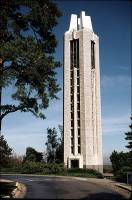
- Flint Hall (Fowler Shops, 1899), Mount Oread (photograph)
-
Toronto Limestone was used in the construction of the building. Photograph courtesy of John Charlton, KGS, Dec. 2002. The source of this material is the Kansas Geological Survey web site at <http://www.kgs.ku.edu/>. All Rights Reserved.

- Lindley Hall, Earth Sciences, Mount Oread (photograph)
-
According to the Kansas Geological Survey photograph caption for Lindley Hall, the building was constructed using both Cottonwood Limestone and Silverdale Limestone. Photograph courtesy of Grace Muilenburg, KGS. Click here for another photograph of Lindley Hall; photograph courtesy of John Charlton, KGS, Dec. 2002. The source of this material is the Kansas Geological Survey web site at <http://www.kgs.ku.edu/>. All Rights Reserved.
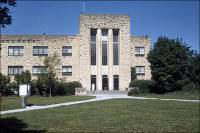
- Marvin Hall (1909), on Mount Oread (photograph)
-
Toronto Limestone was used in the construction of the hall. Photograph courtesy of John Charlton, KGS, Dec. 2002. The source of this material is the Kansas Geological Survey web site at <http://www.kgs.ku.edu/>. All Rights Reserved.
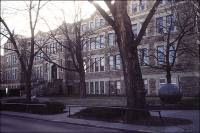
- Museum of Natural History, Dyche Hall (1901) (photograph)
-
Toronto Limestone was used in the construction of the building. Photograph courtesy of John Charlton, KGS, Dec. 2002. The source of this material is the Kansas Geological Survey web site at <http://www.kgs.ku.edu/>. All Rights Reserved.
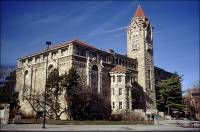
- Old Fraser Hall (photograph)
-
According to the Kansas Geological Survey photograph caption, the hall was constructed with both Oread Limestone and Toronto Limestone. Photograph courtesy of Grace Muilenburg, KGS. The source of this material is the Kansas Geological Survey web site at <http://www.kgs.ku.edu/>. All Rights Reserved.
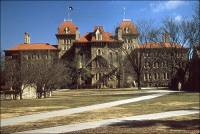
- Spooner Anthropology Museum (1894) (photograph)
-
Toronto Limestone was used in the construction of the museum. Photograph courtesy of John Charlton, KGS, Dec. 2002. The source of this material is the Kansas Geological Survey web site at <http://www.kgs.ku.edu/>. All Rights Reserved.

- World War II Memorial Campanile (photograph and history) The Campanile was built of native Kansas limestone.
- Leavenworth County, Kansas – Limestone Farmhouse (photograph) According to the caption, the farmhouse is constructed with Glacial Erratics. Photograph courtesy of Grace Muilenburg, KGS, July 1962. The source of this material is the Kansas Geological Survey web site at <http://www.kgs.ku.edu/>. All Rights Reserved.
Commercial use of material within this site is strictly prohibited. It is not to be captured, reworked, and placed inside another web site ©. All rights reserved. Peggy B. and George (Pat) Perazzo.